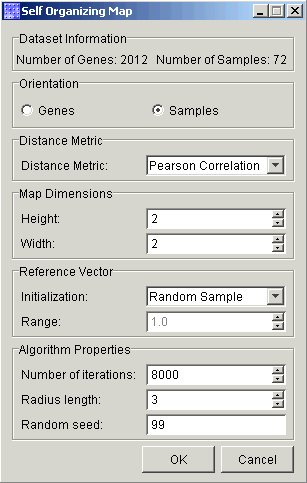|
Tutorial 4: Step 8 Create a SOM Experiment
Create a SOM Experiment
1. If the Norm: log2 dataset in the Experiments navigator is not already highlighted, click it.
2. Click the Self-Organizing
Map toolbar icon ![]() , or select Self-Organizing
Map from the Clustering
menu, or right-click the item and select Self-Organizing Map from the shortcut menu.
The Self-Organizing Map parameters
dialog is displayed.
, or select Self-Organizing
Map from the Clustering
menu, or right-click the item and select Self-Organizing Map from the shortcut menu.
The Self-Organizing Map parameters
dialog is displayed.

3. Set dialog parameters.
|
Parameter |
Setting |
|
Orientation |
Samples |
|
Distance Metric |
Pearson Correlation |
|
Map Dimensions: Height |
2 |
|
Map Dimensions: Width |
2 |
|
Algorithm Properties: Random seed |
99 |
4. Accept all the other defaults and click OK. The SOM operation is performed and a new SOM: samples | 2x2 | Pearson item is added to the Experiments navigator under the original dataset.
If you have automatic visualizations enabled in your user preferences, a SOM plot is displayed.
We are using a low number of nodes in this SOM because we are only looking for a small number of classes among the samples, namely: AML or ALL, and possibly the cell type, B or T.
Note on use of the Random seed parameter: In normal use, setting the random seed is neither necessary nor recommended. In a tutorial you set the random seed to a consistent value so that you will obtain precisely the same results as we depict and discuss, which makes the tutorial easier to understand. When you are not following a tutorial, you should generally not adjust the random seed at all.
The random seed setting may affect irrelevant details, such as the orientation and labelling of the SOM map. In other cases the random seed may affect relevant details, such as which genes occur together in clusters. Because of this latter possibility, it is sometimes worth repeating an experiment with different random seeds to see what the effects are. GeneLinkerô helps with this by setting a new random seed every time an operation is carried out, so you don't need to.
On occasion you may need to determine whether a certain variation in results is due to the random element, or some other cause. For this reason you are able to set the random seed to a fixed value, thus controlling that source of variation.

